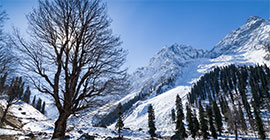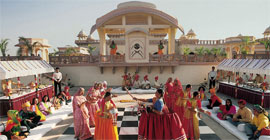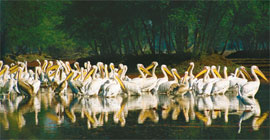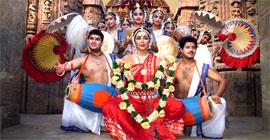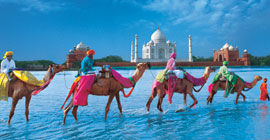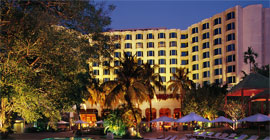ahmedabad
Home | Ahmedabad
Ahmedabad is the largest city in the state of Gujarat and one of the largest urban agglomerations in India, with a population of 45 lakhs (4.5 million).Located on the banks of the River Sabarmati, the city is the administrative centre of Ahmedabad district and was the capital of Gujarat from 1960 to 1970; the capital was shifted to Gandhinagar thereafter. In colloquial Gujarati, it is commonly called Amdavad. Ahmedabad was founded in 1411 by Sultan Ahmed Shah to serve as the capital of the Sultanate of Gujarat. The city is named after its founder. Under British rule, a military cantonment was established and the city infrastructure was modernised and expanded. Although incorporated into the Bombay Presidency during the British rule in India, Ahmedabad remained the most important city in the Gujarat region. The city established itself as the home of a booming textile industry, which earned it the nickname "the Manchester of the East." The city was at the forefront of the Indian independence movement in the first half of the 20th century. It was the centre of many campaigns of civil disobedience to promote workers' rights, civil rights and political independence. With the creation of the state of Gujarat in 1960, Ahmedabad gained prominence as the political and commercial capital of the state. Once characterised by dusty roads and bungalows, the city is witnessing a major construction boom and population increase. A rising centre of , information technology and scientific industries, Ahmedabad remains the cultural and commercial heart of Gujarat and much of western India.
SABARMATI ASHRAM
This ashram was Gandhi's headquarters during the long struggle for Indian independence. His ashram was founded in 1915 and still makes handicraft, handmade paper and spinning wheels. Gandhi's spartan living quarter are preserved as a small museum and there is a pictorial record of the major events in his life. The ashram is open from 8.30 am to 6.30 pm (7 pm between April and September). Admission is free.
There is a sound-and-light show for a small charge at 6:30 pm (in Gujarati) and 8:30 pm (in English on Sunday, Wednesday and Friday and in Hindi on the other nights. The beautiful ashram complex of Ahmedabad, with it's shady trees populated by thousands of parakeets, beeeaters, sunbirds and squirells, offers a refuge from the loud streets of the city, and is one the foremost tourist attractions of Ahmedabad.
KANKARIA LAKE
South-east of the city, this artificial lake, complete with an island summer palace, was constructed in 1415 and has 34 sides, each 60m long. Once frequented by Emperor Jehangir and Empress Nur Jahan, it is now a local picnic spot. There's a huge zoo and children's park by the lake, and the Ghattamendal pavilion in the center houses an aquarium.
JAMA MASJID
The Jama Masjid, built in 1423 by Ahmed Shah, is beside Mahatma Gandhi Rd, to the east of the Teen Darwaja. Although 260 columns support the roof, the two 'shaking' minarets lost half their height in the great earthquake of 1819, and another tremor in 1957 completed their demolition. Much of this early Ahmedabad mosque was built using items salvaged from the demolished Hindu and Jain temples. It is said that a large black slab by the main arch is actually the base of a Jain idol, buried upside down for the Muslim faithful to tread on
RANI SIPRI'S MOSQUE
This small mosque outh-east of the city is also known as the Masjid-e-Nagira (Jewel of a Mosque) because of its extremely graceful and well-executed design. Its slender minarets again blend Hindu and Islamic style. The mosque is said to have been commissioned in 1514 by the wife of Sultan Mahmud Begada after he executed their son for some minor misdemeanour and she is in fact buried here
SARKHEJ ROZA
Travel south along he highway, and a short day tour will bring you to the Sarkhej complex, a cluster of monuments dating from the Sultanate. Sarkhej was the home of the Muslim religious leader Ahmed Shaik, who was a spiritual guide of Sultan Ahmed Shah. In 1411, he was one of the 4 Ahmeds who laid the foundation of the city. The Rauza or Maqbara (mausoleum) of Shaik Ahmed Gunj Baksh - 140 ft in area is one of the largest mausolea in India, rivalling the Taj Mahal.
DADA HARI VAV
Dada Hari Vav (Stepped Well) - This well was built to provide cool resting place and water to the travellers. The stepped well is one the finest example of Gujarati architecture. Even on the hottest days the well is cool. This well was built in 1501. It has a flight of steps leading down to lower and lower platform terminating at a small, octagonal well. The best time to visit and photograph the well is between 10 and 11 am; at other times the sun doesn't penetrate to the various levels.
HATHEE SINGH JAIN TEMPLE
Hathee Singh Jain Temple was built outside Delhi Gate in 1850 by a rich Jain Merchant. This is the best known of Ahmedabad's many ornate Jain Temples. Built of pure white marble and profusely decorated with rich carvings, the Hathee Singh Temple is dedicated to Dharamanath.
LOTHA
Lothal lies 85 km southwest of Ahmedabad. This place near Ahmedabad is an ancient dock belonging to the Indus Valley Civilization. The Indus Valley Civilisation at Lothal Ahmedabad district was a hub centre for the Indus valley civilisation when it moved down from Sindh to the Saurashtra coast to establish trading zones. Rangpur and Lothal, both around 75 kms south from Ahmedabad, were among the first 2 places where the Indus valley civilisation was discovered in India.
The rulers home is no longer a grand palace, but the foundations show signs of it having been a 2 or 3 storeyed mansion. The rooms of the upper town were obviously built for ruling classes, as they had private paved baths, and a remarkable network of drains and cess pools. An ivory workshop at the acropolis suggests that elephants may have been domesticated for the purpose
MODHERA
In 11th century Sun Temple, rivalling Konark in architecture an sculpture, with pillars depicting traditional erotic sculpture and scenes from the Hindu epics can be seen here. One of the finest temples of the 11th century period in the country, the Sun temple of Modhera has spectacular carvings, fine architecture and traditional erotic sculpture.
NAL SAROVAR BIRD SANCTUARY
54 km away and connected the the city, the sanctuary offers a pleasant trip. The sanctuary mainly comprises a lake and marshes where you can see flamingos, pelicans, ducks, geese, cranes, storks, ibises, spoonbills, wading birds, kingfishers, swallows, fishing eagles, osprey, harriers and falcons in great numbers.
THE RANN OF KUTCH DESERT WILDLIFE SANCTUARY
The sanctuary is best known for its herds of chestnut-brown Asiatic onager (wild ass), last surviving species of India's wild horses. Also home of the gazelle, blue bull, wolf, desert and Indian fox, jackal, jungle cat, hare and birds like the houbara bustard, sandgrouse, courser, francolin, quail, eagle, falcon, harrier, vulture, lark, warbler. The 11th century sandstone fortress at Patdi, temples around Munsar Tank at Viramgam and Darbargadh of Dasada can be visited en route.
MEHEDABAD
27 km away and on the way to Baroda, is another interesting day trip. The Stepwell of Mehmedabad and Jumma Masjid mosques are architectural achievements. From here you can go to Sojali by rickshaw to see the 1515 A.D. mausoleum or Chandra Suraj Mahal, a ruined garden palace.







